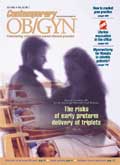Grand Rounds: Counseling couples on risks of early preterm delivery of triplets
Cervical length assessment is just one of several powerful tools for detecting or excluding patients at risk for preterm birth. An expert tells how to assess and counsel a patient pregnant with triplets on her chances of carrying all three fetuses to at least 32 weeks.

Nearly a third of triplets are born very premature and triplets are 12 times more likely to die during the first year than singletons. But when it comes to counseling a woman pregnant with triplets on her risks for a very premature delivery, one size does not fit all. If certain maternal factors and assessments of nutritional status, chorionicity, and amnionicity point to heightened odds for a very premature birth, the couple may need to wrestle with a wrenching decision like multifetal pregnancy reduction (MFPR). On the other hand, if your assessment shows that the woman's chances are far smaller, that more reassuring information can give the couple a more upbeat picture of their specific risks. An important decision like this should not be based on general risk factors, but rather on as much specific information as you can possibly determine.
At age 34, Dina Brennan has had two children by her first husband (a 7-year-old daughter and a 5-year-old son, both spontaneous vaginal deliveries at term) and a third pregnancy that ended in abortion. Divorced and seeking to start a second family with her second husband, she underwent in vitro fertilization and has recently been told that she's carrying triplets. Mrs. Brennan is a Caucasian stay-at-home mom. She is 5 ft 6 in, weighs 148 lb (BMI 23.9), and is physically fit, with a negative medical history. Both deliveries were uncomplicated, resulting in an 8 lb and an 8 lb, 3 oz infant, respectively. She gained between 30 and 35 lb in each of those pregnancies and after her second delivery had both "tubes tied."
After her IVF procedure, in which two fresh blastocysts were transferred, pregnancy was confirmed by an appropriately rising beta hCG titer. Just over a month following the transfer, Mrs. Brennan experienced some vaginal spotting. An ultrasound confirmed a viable triamniotic, dichorionic triplet gestation, each with a crown-rump length consistent with 6 ½ weeks' gestation. An infertility specialist previously counseled the family about MFPR in light of the perinatal risks associated with triplet pregnancies. The family now needs more specific information on her prognosis for carrying her three babies to at least 32 weeks' gestation.
Being able to identify risk factors for very low birthweight (VLBW) delivery or very preterm delivery less than 32 weeks' gestation would help this patient and others in deciding whether to continue a triplet pregnancy or to undergo MFPR.
Study links COVID-19 infection to higher low birthweight and preterm birth rates
March 24th 2025A new study found that pregnant women infected with COVID-19, especially in the third trimester or with severe symptoms, faced higher risks of preterm birth, low birthweight, and neonatal intensive care unit admission.
Read More
Expression of mRNA linked to fetal death risk
March 18th 2025A recent study reveals significantly elevated placental interleukin 6 and vascular endothelial growth factor receptor 2 messenger RNA expression in fetal death cases, highlighting inflammation and impaired fetal protection mechanisms.
Read More
